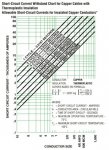Electrical Ninja
New member
- Location
- Baltimore, MD, USA
I have ageneral question about cable protection and Time Current Curves (TCCs). In the past, I haveensured that my TCCs had breaker settings arranged such that conductor thermaldamage curves were always to the right of and above the applicable breaker orfuse curve to ensure protection. In some cases, even when the NEC wouldclassify the feeder cable as being protected (with the ampacity of the cable beingequal to or greater than the breaker long time setting) there might be someoverlap in the instantaneous region (usually an issue with high faultcurrents), or possibly in some other areas of the curve. I would haveclassified this as unprotected cable. I have recently had somediscussions with Schneider Electric where they indicated that the curve overlapwas irrelevant since the conductors were protected per articles 310 and 240 inthe NEC regardless of what the TCC shows.
I amtalking specifically about conductors at 208V or 480V (not medium voltage).
Can youshare if there is a consensus on how we should be dealing with this? Canwe ignore overlap as long as the long time setting of the breaker is set below thefeeder ampacity (assuming the breaker fault current rating is adequate ofcourse)?
Thanksfor any input you can provide.
I amtalking specifically about conductors at 208V or 480V (not medium voltage).
Can youshare if there is a consensus on how we should be dealing with this? Canwe ignore overlap as long as the long time setting of the breaker is set below thefeeder ampacity (assuming the breaker fault current rating is adequate ofcourse)?
Thanksfor any input you can provide.

